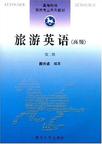旅游英语
出版时间:2004-1 出版社:南开大学出版社 作者:段开成 页数:375
前言
自本教材1998年出版以来,全球旅游业经历了巨大的变化,其间世界经济的持续低迷、“9•11”恐怖袭击、“非典”疫情等对旅游业的冲击更是超出人们的想像,被称为“完美风暴”。上个世纪末人们对旅游业这个朝阳产业的持续增长怀着美好的憧憬,而现在这似乎已经被“完美风暴”击碎。在此背景下修订本教材,编著者无意更新课文中涉及的旅游业的统计或预计数字,希望旅游管理专业学生能够保留对旅游业的美好憧憬。编著者此次修订保持了原有的体例,主要做了以下几件事情:1.改正了98版中的印刷错误;2.更新了原有注释的内容,增补了一‘些有关旅游企业、人物、景观介绍的注释;3.尽可能地提供有关网址,以便学生学会利用网络资源,自己更新相关知识。本教材中阅读与翻译练习的参考答案,不便在教材中提供,以免影响教师授课效果。
内容概要
《旅游英语(高级)》是国内首本集旅游英语实用口语、旅游英语专业文献阅读、旅游管理专业英中文口笔翻译、旅游应用文写作于一体的综合性专业教材,适用于旅游管理专业高年级学生、旅游业管理人员、旅游英语自学人士。全书共分21课,每课均有中英交际文化对比、中英语言对比、中英口笔翻译技巧对比、英语写作知识等方面的介绍短文。本教材力求做到基础与专业相结合、知识与技能相结合,介绍国际旅游新动态,全面提高学生旅游英语综合交际能力,培养旅游业跨世纪人才。 对于使用本教材的旅游管理专业本科英语教师,编者建议:切勿机械地采用传统的精读课或四、六级统考的教学方法来讲授本教材,而应根据本校旅游管理专业的培养目标、旅游业的实际发展状况、学生的英语水平以及对旅游业现状的了解程度和实际需要,来确定本教材的使用时间长度;灵活地使用本教材,在教学中对本教材的各种内容进行适当的删减或增加,特别多练,充分发挥学生的主观能动性,让学生多读、多想、多做,以全面提高学生的英语实际应用水平。
书籍目录
再版前言PAEFACELESSON ONE Text Travel and tourism Part Ⅰ Reading comprehension Part Ⅱ Spoken english in tourism Part Ⅲ Translation and interpretation Part Ⅳ WritingLESSON TWO Text Tourism products Part Ⅰ Reading comprehension Part Ⅱ Spoken english in tourism Part Ⅲ Translation and interpretation Part Ⅳ WritingLESSON THREE Text travelers Part Ⅰ Reading comprehension Part Ⅱ Spoken english in tourism Part Ⅲ Translation and interpretation Part Ⅳ WritingLESSON FOUR Text Travel agency Part Ⅰ Reading comprehension Part Ⅱ Spoken english in tourism Part Ⅲ Translation and interpretation Part Ⅳ WritingLESSON FIVE Text Airline Economics Part Ⅰ Reading comprehension Part Ⅱ Spoken english in tourism Part Ⅲ Translation and interpretation Part Ⅳ WritingLESSON SIX Text The lodging industry Part Ⅰ Reading comprehension Part Ⅱ Spoken english in tourism Part Ⅲ Translation and interpretation Part Ⅳ WritingLESSON SEVEN Text Destinations:Tourism Generators Part Ⅰ Reading comprehension Part Ⅱ Spoken english in tourism Part Ⅲ Translation and interpretation Part Ⅳ WritingLESSON EIGHT Text Management:A new of way of thinking Part Ⅰ Reading comprehension Part Ⅱ Spoken english in tourism Part Ⅲ Translation and interpretation Part Ⅳ WritingLESSON NINE Test Marketing in tourism Part Ⅰ Reading comprehension Part Ⅱ Spoken english in tourism Part Ⅲ Translation and interpretation Part Ⅳ WritingLESSON TEN Test Tourism organizations Part Ⅰ Reading comprehension Part Ⅱ Spoken english in tourism Part Ⅲ Translation and interpretation Part Ⅳ WritingLESSON ELEVEN Test Tourism research Part Ⅰ Reading comprehension Part Ⅱ Spoken english in tourism Part Ⅲ Translation and interpretation Part Ⅳ WritingLESSON TWELVE Test theme parks Part Ⅰ Reading comprehension Part Ⅱ Spoken english in tourism Part Ⅲ Translation and interpretation Part Ⅳ WritingLESSON THIRTEEN Text The social Impact of tourism Part Ⅰ Reading comprehension Part Ⅱ Spoken english in tourism Part Ⅲ Translation and interpretation Part Ⅳ WritingLESSON FOURTEEN Text Tourism planning Part Ⅰ Reading comprehension Part Ⅱ Spoken english in tourism Part Ⅲ Translation and interpretation Part Ⅳ WritingLESSON FIFTEEN Text Ecotourism Part Ⅰ Reading comprehension Part Ⅱ Spoken english in tourism Part Ⅲ Translation and interpretation Part Ⅳ WritingLESSON SIXTEEN Text sustainable development in tourism Part Ⅰ Reading comprehension Part Ⅱ Spoken english in tourism Part Ⅲ Translation and interpretation Part Ⅳ WritingLESSON SEVENTEEN Text computers in the hospitality Industry Part Ⅰ Reading comprehension Part Ⅱ Spoken english in tourism Part Ⅲ Translation and interpretation Part Ⅳ WritingLESSON EIGHTEEN Text Advertising and public relations in tourism Part Ⅰ Reading comprehension Part Ⅱ Spoken english in tourism Part Ⅲ Translation and interpretation Part Ⅳ WritingLESSON TWENTY Text Cross-cultural communications in tourism Part Ⅰ Reading comprehension Part Ⅱ Spoken english in tourism Part Ⅲ Translation and interpretation Part Ⅳ WritingLESSON TWENTY-ONE Text The future of tourism Part Ⅰ Reading comprehension Part Ⅱ Spoken english in tourism Part Ⅲ Translation and interpretation Part Ⅳ WritingGLOSSARYVOCABULARYREFERENCE BOOKS
章节摘录
It is sometimes debated whether there truly exists a travel industry in the sense of a distinct group of enterprises such as the steel, automobile, or electronic industries. Part of the problem is that the term industry is more commonly identified with manufacturing and production-based enterprises, and the other part of the problem is that the travel industry is not one industry, but, in reality, a collection of businesses all selling travel-related services. The general public is likely to be more familiar with each component of the travel industry, that is, the airline industry, the hotel industry, the restaurant industry, or the entertainment business, etc. The individual industries also do not necessarily act together as an integrated group and very often have conflicting views among themselves. In addition, there are businesses involved that serve both travelers and residents with respect to eating, shopping, recreation, and entertainment. However, ever since the 1960s, more and more people have begun to view travel as an industry, rather than as a miscellaneous collection of transportation companies. Moreover, with the billions of dollars in income it generates, travel can certainly be categorized as an industry.The travel industry comprises thousands of diverse organizations and businesses that are involved directly or indirectly in producing and providing products and services for travelers. These businesses range in size from small companies to multinational corporations, and are categorized by some as direct providers, support services, and developmental organizations.The first category, direct providers, includes businesses typically associated with travel, such as airlines, hotels, ground transportations, travel agencies, restaurants and retail shops. These businesses provide services, activities, and products that are consumed or purchased directly by the travelers. They tend to reflect those sectors of the travel industry that are visible to the travelers.Below the surface of direct providers lies a large variety of businesses lending support to direct providers. These support services include specialized services, such as tour organizers, travel and trade publications, hotel management firms, and travel research firms, and basic supplies and services, such as contract laundry and contract food service.
图书封面
评论、评分、阅读与下载
用户评论 (总计14条)
- 用于大学的选修课,还不错。
- 纸张质量不怎么好,发货快。
- 书的质量很好,里面字迹也很清楚。快递很快,包装的也好,书没有一点损坏。
- 版面,纸质都不错
- 书本有难度。有大量练习,尤其是阅读,文章长度较长。整本书对提高读、写、翻译水平很有帮助,书中也有很多针对旅游英语口语的练习。总体来说是很不错的教材,适合旅游英语专业中年级学生。
- 书是很难,但内容还可以,很有用.
- 书很难啊,看不懂.没有一个汉字啊.真痛苦.后悔啊.
- 已经过时的了!用不了
- 亚马逊发货速度给力,物流很给力。而且图书种类齐全,毫不费力的搜索到要考试书籍!很喜欢!本月第二次来了,共买了5本!
- 帮同学买的,我没有看到书,同学说有点像是盗版书
- 书很好,内容很丰富,感觉能学到很多东西。但就是觉得纸张摸起来不是很舒服。
- 不实用,被我遗弃到角落了。。。
- 这本书是我们旅游管理专业的英语老师指定的上课用书~~
- 请问这本书有没有相关配套的翻译教材?
推荐图书
- 电工学•电子技术(第五版)全程辅导上册精教•精学•精练 (平装)
- 小学语文教学评价/中小学语文教师继续教育丛书
- 小学语文口语交际教案选粹
- 最新执业医师资格综合笔试一本通(临床分册)
- 中学英语要点速记随身酷(初2)
- 中学英语要点速记随身酷(初3)
- 硝烟散发的诗情
- 中国二胡名曲集锦
- 小品摄影
- 实用微距花卉摄影
- 智力游戏
- 启蒙英语
- 黄冈兵法·高一生物
- 黄冈中考兵法·政治
- 同步学案黄冈兵法:高2政治(下)(人教版)(新教材) (平装)
- 同步学案黄冈兵法:高1政治(上)(人教版新教材) (平装)
- 黄冈中考兵法·化学
- 达·芬奇漫画名人传记
- 追根溯源300问
- 风雅钱塘<第2辑>(附光盘)
- 中国现代散文精华(少年版)
- 小学数学能力拔高60课一学一练
- 为什么数字使我们失去理性
- 中小型高科技企业
- 大扁头的两个宠物/快乐少年系列
